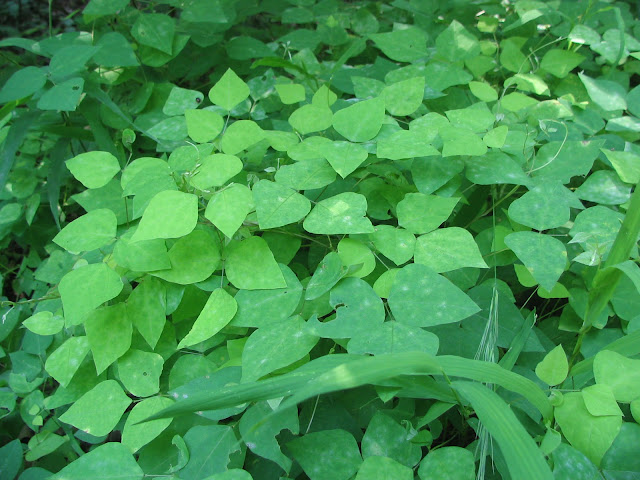This plant is unusual because it produces seeds above and below the ground and two types of flowers. Hog peanuts are in the pea family (Fabaceae) and can be found in Connecticut. Native Americans used this plant primarily as a source of food although they did find several medicinal uses for it.
Amphicarpaea bracteata, or the American Hog Peanut is native to eastern North America and can be found from Manitoba east to Nova Scotia, Canada, south to Florida, and west to Texas and Montana. It is found in moist woods, meadows, and prairies and is often considered a weed. This plant grows from a seed and produces a twining branched stem that can grow up to five feet long from a tap root. It climbs other plants without tendrils by coiling the apical portion of the stem around them. The stem is slender and hairy and the leaves of this plant are broad and oval in shape. The leaves turn yellow in the fall. This plant produces two types of flowers. On the upper branches, the plant produces pendant-shaped flowers that bloom in clusters and droop from the stems. The flowers can be white, pink, lilac, or pale purple and bloom in August and September. The flowers are followed by flat oblong spotted pods that are pointed at each end and contain three or four small seeds. The flowers that bloom on the lower branches of this plant don't have petals and don't open. The flowers rest on or under the ground and are followed by a fleshy pod that buries under the soil the way peanuts do.
Culinary and Medicinal Uses
Many Native American communities collect the "peanut" that grows underground and eat it. The seeds or "peanuts" are eaten raw or boiled to remove the husk and then eaten like a nut. The beans are also used to make bean bread. Some communities cook the seeds like pinto beans and add them to cornmeal. The pods produced on the upper branches were also collected and eaten. Since these seeds are much smaller they had to be cooked before they were eaten. The entire plant was used for several medicinal purposes. One of the most common uses was to make an infusion of the root to treat diarrhea. Many communities made a poultice of pulverized leaves and applied the mixture to swellings. The Cherokee make an infusion of the plant and use it to treat snake bites.
 |
| Hog Peanut Flower wrapped around a Christmas Fern |
The genus name refers to the fact that this plant produces two different types of flowers and seeds. Greek amphi meaning of both kinds and carpos means fruit.
The common name, refers to the underground fruit or peanuts that are often dug up and eaten by wild pigs.
It is a larval host for silver spotted skipper and northern cloudwing butterflies.


No comments:
Post a Comment